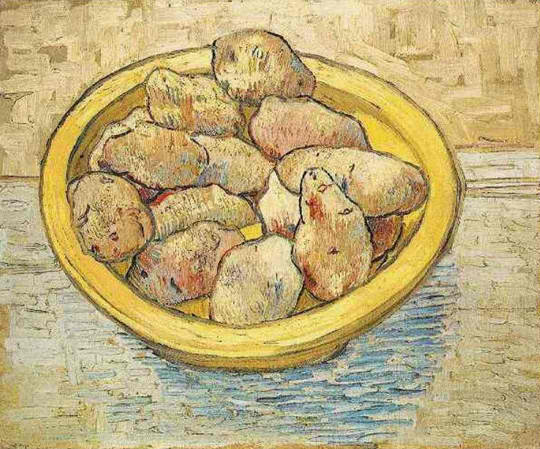 The historical trajectory of potatoes joined ours sometime between 8,000 and 5,000 B.C. The Incas developed enough different varieties that, according to National Geographic, they could glean every nutrient needed for survival from a potato-only diet. They included spuds in their prayers.
The historical trajectory of potatoes joined ours sometime between 8,000 and 5,000 B.C. The Incas developed enough different varieties that, according to National Geographic, they could glean every nutrient needed for survival from a potato-only diet. They included spuds in their prayers.
The rest of the world was not so enamored. When the Conquistadors introduced potatoes to Europe in the 1500s, folks suspected them not merely deficient for human consumption, but injurious. They are not mentioned, after all, in the Bible. Their lumps and eyes suggested disease in an age in which the appearance of a vegetable was often thought to reflect the maladies it could cause or cure. In 1633, French Burgundy felt the need to pass a law forbidding people “to make use of these tubers, because they are assured that the eating of them causes leprosy.” Amongst the other diseases the potato was accused of causing was an unchained sexuality, making the fact that their cultivation took off in Catholic Ireland well before England or the Continent enjoyably ironic. For a couple hundred years after Europe’s invasion of the Americas, most countries outside of South America settled on using them as farm animal fodder and left it at that.
But nothing cuts life to the chase like war and famine. Potatoes mature quicker and produce more calories per acre than any of the traditional grains. When famines began to decimate the working populations of Europe, monarchs pushed for their acceptance. But they were a tough sell. To get the peasants cultivating them, for instance, the kings of Austria had to threaten them with 40 lashes if they refused. In 1740, Frederick the Great of Prussia distributed cultivation guides to his subjects and made potato promotion official government policy. As opposed to grains, which could be easily burned by invading armies, potatoes could stay hidden beneath the soil of farms and the boots of soldiers, saving civilians and lessening war’s economic burden.
Frederick helped set up one of those wars the same year when he carved off a piece of Austria for himself. Once that indiscretion flamed up into the Seven Years War/French and Indian War, he ended up with a French pharmacist named Antoine-Augustin Parmentier locked in one of his prisons and fed on nothing but the ‘tater.
He would do more for the flourishing of the potato in Europe than any other man, making them an object of high fashion, which I will get into on Thursday.
In the meantime, enjoy this picture of the man. Though I presume he was slick and dreamy for his time since Marie-Antoinette let him into her court, he reminds me a bit of a Warner Brothers’ cartoon, someone with an exaggerated chin sitting at a piano next to Clark Gable or Jack Benny.
An Edible History of Humanity by Tom Standage was a primary source for this post.

Pingback: Dead Man Gnawing: The Leprous Potato and a Hint of High Fashion Part II (1786) | PitchKnives and Butter Forks
Hi, just wanted to mention, I enjoyed this article. It was helpful. Keep on posting!
Pingback: Cool Things I Learned from “The New York Times Magazine’s Food & Drink Issue”: | PitchKnives and Butter Forks